Antarctic Peninsula
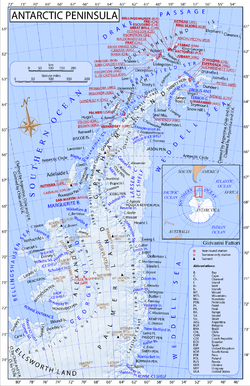
The Antarctic Peninsula is the northernmost part of the mainland of Antarctica; The Tierra del Fuego, the southernmost tip of South America, lies only about 621 miles away across the Drake Passage. The peninsula is wholly within the British Antarctic Territory and divided into Graham Land to the north and Palmer Land to the south. It is dotted with numerous research stations of various nations.
At the surface, the Antarctic Peninsula is the biggest, most prominent peninsula in Antarctica as it extends 808 miles from a line between Cape Adams (on the Weddell Sea) and a point on the mainland south of Eklund Islands.
From the middle of the nineteenth century the peninsula was known as Graham's Land or Graham Land, at least by the British Admiralty. However the Americans took to calling it Palmer Land after an American sealing captain, and its current divided name is a compromise reached in 1964.
Beneath the ice sheet covering it, the Antarctic Peninsula consists of a string of bedrock islands that are separated by deep channels whose bottoms lie at depths considerably below current sea level and are joined together by a grounded ice sheet.
History
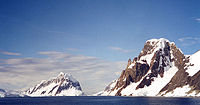
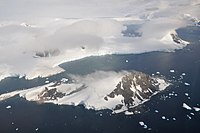
Discovery and naming
The first sighting of the coast here is disputed but apparently occurred in 1820. The most likely first sighting of the Antarctic mainland, which was also the Antarctic Peninsula, was probably during an expedition of the Russian Imperial Navy that was captained by Fabian Gottlieb von Bellingshausen. The party did not recognize what they thought was an icefield covered by small hillocks as the mainland on 27 January 1820. Edward Bransfield and William Smith were the first to chart a part of the Antarctic Peninsula just three days later on the 30 January 1820. The location was later to be called Trinity Peninsula, the extreme northeast portion of the peninsula. The next confirmed sighting was by John Biscoe who named the land "Graham Land", in 1832.[1][2]
The first to make landing on the continent is also disputed. A 19th century seal hunter called John Davis was almost certainly the first, however sealers were secretive about their movements and their ship logs were deliberately unreliable, in order to protect any new sealing grounds from competition.[1]
Between 1901 and 1904, Otto Nordenskiöld led the Swedish Antarctic Expedition, one of the first expeditions that was to explore parts of Antarctica. They landed on the Antarctic Peninsula in February 1902, aboard the Antarctica which later sank not far from the peninsula with all crew saved. They were later rescued by an Argentine ship. The British Graham Land Expedition between 1934 and 1937 carried out aerial surveys and concluded that Graham Land was not an archipelago but was a peninsula.[1][2]
In 1964 the United Kingdom Antarctic Place Names Committee (the "UK-APC") and the United States Advisory Committee on Antarctic Names ("US-ACAN") and reached an agreement on the name "Antarctic Peninsula" which thus resolved a long-standing difference over the use by the Americans of the name "Palmer Peninsula" instead of British name "Graham Land". The dispute was solved by making Graham Land the part of the Antarctic Peninsula northward of a line between Cape Jeremy and Cape Agassiz and Palmer Land the part southward of that line. Palmer Land is named for the United States' seal hunter, Nathaniel Palmer.
Other portions of the peninsula that were named after various expeditions made their discovery include Bowman Coast, Black Coast, Danco Coast, Davis Coast, English Coast, Fallieres Coast, Loubet Land, Nordenskjold Coast and the Wilkins Coast.
Research stations
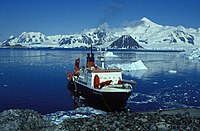
The 1950s saw a marked increase in the number of research bases as Britain, Chile and Argentina competed to make claims over the same area.[3] Meteorology and geology were the primary research subjects.
Since the peninsula has the mildest climate in Antarctica, the highest concentration of research stations on the continent can be found there, or on the many nearby islands, and it is the part of Antarctica most often visited by tour vessels and yachts. Occupied bases include those of several nations, amongst them the chief base of the British Antarctic Survey, Rothera. There are also many abandoned scientific and military bases. Ice core and sediment samples from the peninsula are valuable because events such as the Little Ice Age can be verified with samples from other continents.
Recent
The RRS Bransfield was the name of the ship that transported the secret British expedition to Antarctica during World War Two, during which the first permanent British bases on the Antarctic Peninsula were established.
Tourism to the Antarctic Peninsula began in the 1950s. Most ship-based tourists depart for the peninsula from Ushuaia in Argentina.
There have however been accidents, groundings and perils, which the remote and unforgiving location render all the more perilous.
Geography
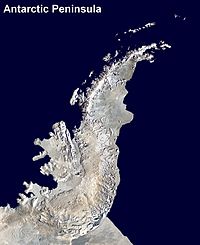
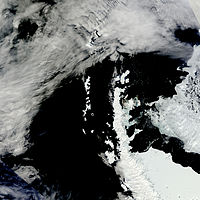
The peninsula is highly mountainous, its highest peaks rising to approximately (9,200 feet). The highest point is Mount Jackson at 10,446 feet; the highest point in any British territory. Other notable peaks on the Antarctic Peninsula include Mount Castro, Mount Coman, Mount Gilbert, Mount William, Mount Owen and Mount Scott.
The landscape of the peninsula is typical Antarctic tundra. The peninsula has a sharp elevation gradient, with glaciers flowing into the Larsen Ice Shelf (which experienced significant breakup in 2002). Other ice shelves on the peninsular include George VI Ice Shelf, Wilkins Ice Shelf, Wordie Ice Shelf and the Bach Ice Shelf. East of the peninsula in the Weddell Sea is the Ronne Ice Shelf.
Islands along the peninsula are mostly ice covered and connected to the land by pack ice.[4] Separating the peninsula from nearby islands is the Antarctic Sound, Erebus and Terror Gulf, George VI Sound, Gerlache Strait and the Lemaire Channel. The Lemaire Channel is a popular destination for tourist cruise ships that visit Antactica. Further to the west lies the Bellingshausen Sea and in the north is the Scotia Sea. The Antarctic Peninsula and Cape Horn create a funneling effect, which channels the winds and tides into the relatively narrow Drake Passage.
Hope Bay, at 63° 23' S 57° W, is near to the northernmost extremity of the peninsula, which is Prime Head, at 63º13'S. Near the tip at Hope Bay is Sheppard Point. The part of the Antarctic Peninsula extending northeastwards from a line connecting Cape Kater to Cape Longing is called the Trinity Peninsula. Brown Bluff is a rare tuya and Sheppard Nunatak is found here also. The Airy Glacier, Seller Glacier, Fleming Glacier and Prospect Glaciers form the Forster Ice Piedmont along the west coast of the Antarctic Peninsula. Charlotte Bay, Hughes Bay and Marguerite Bay are located on the west coast as well.
On the east coast is the Athene Glacier while the Arctowski Nunatak and Akerlundh Nunatak are both located just off the east coast. A number of smaller peninsulas extend from the main Antarctic Peninsula including Hollick-Kenyon Peninsula and Prehn Peninsula at the base of the Antarctic Peninsula. Also located here are the Scaife Mountains. The Eternity Range is found in the middle of the peninsula. Other geographical features include Avery Plateau, the twin towers of Una's Tits.
Flora and fauna
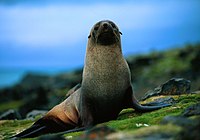
The coasts of the peninsula have the mildest climate in Antarctica and moss and lichen-covered rocks are free of snow during the summer months, although the weather is still intensely cold and the growing season very short. The plant life today is mainly mosses, lichens and algae adapted to this harsh environment, with lichens preferring the wetter areas of the rocky landscape. The most common lichens are Usnea and Bryoria species. Antarctica's two flowering plant species, the Antarctic hair grass (Deschampsia antarctica) and Antarctic pearlwort (Colobanthus quitensis) are found on the northern and western parts of the Antarctic Peninsula, including offshore islands, where the climate is relatively mild. Lagotellerie Island in Marguerite Bay is an example of this habitat.[5][6][7]
Antarctic krill are found in the seas surrounding the peninsula and the rest of the continent. The Crabeater Seal spends most of its life in the same waters feeding on krill. Bald notothen is a cryopelagic fish that lives in sub-zero water temperatures around the peninsula. Vocalizations of the Sei Whale can be heard emanating from the waters surrounding the Antarctic Peninsula.[5]
The animals of Antarctica live on food they find in the sea, not on land, and include seabirds, seals and penguins. The seals include: Leopard Seal (Hydrurga leptonyx), Weddell Seal (Leptonychotes weddellii), the huge Southern Elephant Seal (Mirounga leonina), and Crabeater Seal (Lobodon carcinophagus).[5]
The Antarctic Fur Seal once reduced to a small population on South Georgia after being hunted towards extinction, has returned to the waters around the Antarctic Peninsula.
Penguin species found on the peninsula, especially near the tip and surrounding islands, include the Chinstrap Penguin, Emperor Penguin, Gentoo penguin and the Adelie Penguin. Petermann Island is the world's southernmost colony of Gentoo Penguins. The exposed rocks on the island is one of many locations on the peninsula that provides a good habitat for rookeries. The penguins return each year and may reach populations of more than ten thousand. Of these the most common on the Antarctic Peninsula are the chinstrap and gentoo, with the only breeding colony of Emperor Penguins in West Antarctica an isolated population on the Dion Islands, in Marguerite Bay on the west coast of the peninsula. Most emperor penguins breed in East Antarctica[5][6][7]
Seabirds of the Southern Ocean and West Antarctica found on the peninsula include: Southern Fulmar (Fulmarus glacialoides), the scavenging Southern Giant Petrel (Macronectes giganteus), Cape Petrel (Daption capense), Snow Petrel (Pagodroma nivea), the small Wilson's Storm-petrel (Oceanites oceanicus), Imperial Shag (Phalacrocorax atriceps), Snowy Sheathbill (Chionis alba), the large South Polar Skua (Catharacta maccormicki), Brown Skua (Catharacta lönnbergi), Kelp Gull (Larus dominicanus), and Antarctic Tern (Sterna vittata). The Imperial Shag is a cormorant which is native to many subantarctic islands, the Antarctic Peninsula and southern South America.[5][6]
Paleofloras and Paleofaunas
A rich record of fossil leaves, wood, pollen, and flowers demonstrates that flowering plants thrived in subtropical climates within the volcanic island arcs that occupied the Antarctic Peninsula region during the Cretaceous and very early Paleogene periods. The analysis of fossil leaves and flowers indicate that semitropical woodlands, which were composed of ancestors of plants that live in the tropics today, thrived within this region during a global thermal maximum with summer temperatures that averaged 20°C. The oldest fossil plants come from the middle Cretaceous (Albian) Fossil Bluff Group, which outcrop along the edge of Alexander Island. These fossils reveal that at this time the forests consisted of large conifers, with mosses and ferns in the undergrowth. The paleosols, in which trees are rooted, have physical characteristics indicative of modern soils that form under seasonally dry climates periodic high rainfall. Younger Cretaceous strata, which outcrop within James Ross, Seymour, and adjacent islands, contain plants fossil of Late Cretaceous angiosperms with leaf morphotypes that are similar to those of living families such as Sterculiaceae, Lauraceae, Winteraceae, Cunoniaceae, and Myrtaceae. They indicate that the emergent parts of the volcanic island arc, the eroded roots of which now formed the central part of the Antarctic Peninsula, were covered by either warm temperate or subtropical forests.[8] These fossil plants are indicative of tropical and subtropical forest at high paleolatitudes during the Middle and Late Cretaceous, which grew in climates without extended periods of below freezing winter temperatures and with adequate moisture for growth.[9] The Cretaceous strata of James Ross Island also yielded the dinosaur genera Antarctopelta, which was the first dinosaur fossil to be found on Antarctica.[10]
Paleogene and Early Eocene marine sediments that outcrop on Seymour Island contains plant-rich horizons. The fossil plants are dominated by permineralized branches of conifers and compressions of angiosperm leaves, and found within carbonate concretions. These fossils, which date to about 51.5-49.5 Ma, are dominated by leaves, cone scales, and leafy branches of araucarian conifers, very similar in all respects to living Araucaria araucana (monkey puzzle) from Chile. They suggest that the adjacent parts of the prehistoric Antarctic Peninsula were covered by forests that grew in a cool and moist, high-latitudes environment during the early Eocene.[9]
During the Cenozoic climatic cooling, the Antarctic Peninsula was the last region of Antarctica to have been fully glaciated according to current research. As a result, this region was likely the last refugium for plants and animals that had inhabited Antarctica after it separated from the Gondwana supercontinent. Analysis of paleontologic, stratigraphic, and sedimentologic data acquired from the study of drill core and siesmic acquired during the Shallow Drilling on the Antarctic Continental Shelf (SHALDRIL) and other projects and from fossil collections from and rock outcrops within Alexander, James Ross, King George, Seymour, and South Shetland islands has yielded a record of the changes in terrestrial vegetation that occurred within the Antarctic Peninsula over the course of the past 37 million years.[11][9]
This research found that vegetation within the Antarctic Peninsula changed in response to a progressive climatic cooling that started with the initiation of mountain glaciation in the latest Eocene, about 37–34 Ma. The cooling was contemporaneous with glaciation elsewhere in Antarctica and a reduction in atmospheric CO2 concentrations. Initially, during the Eocene, this climate cooling resulted in a decrease in diversity of the angiosperm-dominated vegetation that inhabited the northern Antarctic Peninsula. During the Oligocene, about 34–23 Ma, these woodlands were replaced by a mosaic of southern beech (Nothofagus) and conifer-dominated woodlands and tundra as the climate continued to cool. By middle Miocene, 16–11.6 Ma, a tundra landscape completely replaced any remaining woodlands. At this time, woodlands became completely expatriated from the Antarctic Peninsula and all of Antarctica. A tundra landscape likely persisted until about 12.8 Ma when the transition from a temperate, alpine glaciation to a dynamic ice sheet occurred. Eventually, the Antarctic Peninsula was overridden by an ice sheet, which has persisted without any interruption to this day, in the early Pliocene, about 5.3–3.6 Ma.[11][9]
Outside links
| ("Wikimedia Commons" has material about Antarctic Peninsula) |
- "Of Ice and Men" Account of a tourist visit to the Antarctic Peninsula by Roderick Eime
- Biodiversity at Ardley Island, South Shetland archipelago, Antarctic Peninsula
- 89 photos of the Antarctic Peninsula
References
- ↑ 1.0 1.1 1.2 Stewart, 2008
- ↑ 2.0 2.1 Scott, Keith (1993). The Australian Geographic book of Antarctica. Terrey Hills, New South Wales: Australian Geographic. pp. 114—118. ISBN 1-86276-010-1.
- ↑ Thomson, Michael; Charles Swithinbank (1 August 1985). "The prospects for Antarctic Minerals". New Scientist (1467): 31–35.
- ↑ Tulloch, Coral (2003). Antarctica: Heart of the World. Sydney: ABC Books. pp. 40. ISBN 0-7333-0912-7.
- ↑ 5.0 5.1 5.2 5.3 5.4 Moss, 1998
- ↑ 6.0 6.1 6.2 World Wildlife Fund, 2009
- ↑ 7.0 7.1 World Wildlife Fund, C. M. Hogan, S. Draggan. (2011) Marielandia Antarctic tundra. in C. J. Cleveland, ed., Encyclopedia of Earth. National Council for Science and the Environment, Washington, DC
- ↑ Hayes & others, 2006
- ↑ 9.0 9.1 9.2 9.3 Francis, 2008
- ↑ Salgado, L., and Z. Gasparini (2006) Reappraisal of an ankylosaurian dinosaur from the Upper Cretaceous of James Ross Island (Antarctica). Geodiversitas. v. 28, no. 11, pp. 119-135.
- ↑ 11.0 11.1 Anderson, 2012
